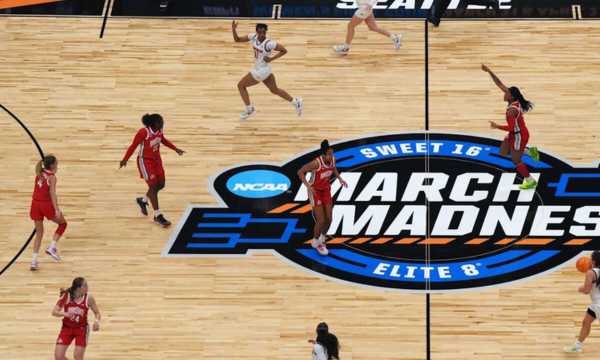March Madness: Discover the Biggest College Championship
March Madness transforms the month of March into an epic celebration of American college basketball with excitement, surprises, and inspiring stories.
Ad
The success of the tournament lies in the unlikely upsets, admirers college fans, and the emergence of future NBA stars.
In the following sections, we’ll dive into the fascinating universe of March Madness, unraveling its history, format, and the moments that made it one of the greatest sporting competitions on the planet.
1. What is March Madness?
March Madness is the official nickname for the NCAA Men’s and Women’s College Basketball Tournament, held annually between March and April in the United States.

March Madness Tournament (Google source)
The term was popularized by commentator Brent Musburger during tournament coverage in 1982, perfectly capturing the intensity and unpredictability of the competition.
This sporting tradition that began in 1939 has evolved into a cultural phenomenon that transcends the courts.
The tournament’s format is based on single elimination, where one loss means the end of the journey for the team.
This selection system generates the characteristic tension of the tournament, allowing for major surprises when smaller teams defeat traditional powerhouses.
The men’s tournament brings together 68 teams competing in 67 games over three frantic weeks of competition.
Unlike professional leagues, the emotional connection involves institutional pride and centuries-old academic traditions.
This mixture of educational admiration with sporting competition creates an incomparable atmosphere in world sports.
2. The Magical Key to the Championship
This system organizes the 68 teams into four geographic regions (East, West, South, and Midwest), each with 16 to 18 teams distributed hierarchically.
The traditional bracket follows a single-elimination format, starting with the “First Round” (after the play-in known as the “First Four”).
Teams receive classifications (seeds) from 1 to 16 in each region, with the strongest teams occupying the highest positions.
This structure creates initial matchups between powerhouses and smaller teams, like the always feared duel between 5 and 12 seeds, famous for its upsets.
The theoretical path favors the highest-ranked teams, who face theoretically weaker opponents in the early rounds. Bracket structure by stages:
- First Four: Elimination games to define the last four spots.
- First Round: 32 games with the remaining 64 teams.
- Second Round: 16 games defining the survivors (Sweet Sixteen).
- Regional Semifinal (Sweet 16): 8 games between the best 16.
- Regional Final (Elite 8): 4 games that define the regional champions.
- Final Four: National semifinals between regional champions.
- National Championship: The championship decided in a single game.
3. Rules and Formats of March Madness
March Madness follows the official rules of NCAA college basketball, with some particularities that differentiate it from professional basketball.

NCAA Women's Basketball Tournament (Source Google)
- Game time is divided into two 20-minute halves, in contrast to the NBA’s four 12-minute quarters.
- This structure creates its own dynamic where each possession has increased value.
- Teams have 30 seconds to finish their attack (versus 24 seconds in the NBA), favoring more elaborate and strategic plays.
- The court dimensions are identical to professional ones, but the three-point line is positioned at 6.75 meters (closer than the NBA’s 7.24 meters).
These subtle differences significantly influence the style of play presented during this college tournament. Key specific rules:
- Five personal fouls eliminate a player (six in the NBA).
- The shot clock doesn’t reset to 14 seconds after offensive rebounds.
- Absence of the “defensive three seconds” rule.
- No limit on team fouls per period.
- Tied games go to 5-minute overtimes until there’s a winner.
The single-elimination format creates immense pressure on college players, many aged 18-22.
Unlike professional playoff series, there’s no second chance – a single bad game or moment of inattention can end the season.
This unforgiving reality amplifies the drama in each confrontation, generating the “upsets” that define the tournament.
4. How the 68 Spots are Defined
The selection process for March Madness combines automatic qualification with selection committee choices, ensuring a balance between recognition of direct achievements and subjective performance evaluation.
Of the 68 spots in the men’s tournament, 32 are filled by conference champions, who receive automatic entries.
The remaining 36 spots, known as “at-large bids,” are determined by the NCAA Selection Committee.
This committee, composed of athletic directors and conference commissioners, uses various criteria to evaluate teams during a process known as “Selection Sunday”.
The NET (NCAA Evaluation Tool) replaced the RPI as the main metric in 2018, incorporating advanced statistics to rank all 358 Division I teams. Factors considered by the committee:
- NET ranking and quadrant of victories (classification of wins by difficulty).
- Strength of schedule played during the regular season.
- Performance against high-level opponents (Quadrant 1).
- Performance away from home (road games and at neutral sites).
- Advanced metrics like KenPom, BPI, and Sagarin Ratings.
- Quality of wins and the “smell test” of losses.
After selecting the 68 teams, the committee conducts the “seeding” (classification) and regional distribution, seeking competitive balance between regions.
Teams receive seeds from 1 to 16 in each region, with the four best teams in the tournament receiving the coveted “number 1 seeds.”
Geographic considerations try to keep teams close to their bases, minimizing excessive travel.
5. Remember Incredible Moments of Teams Overcoming the Odds
The “Cinderella Story” is a beloved tradition in the tournament, describing low-seeded teams that exceed expectations, advancing deep into the tournament.
In 2018, the University of Maryland-Baltimore County (UMBC) led the biggest upset in tournament history by defeating Virginia by an impressive 20 points. This victory represented the first time a 16 seed beat a 1 seed in the men’s tournament, after 135 consecutive losses in this type of matchup.
Butler’s unlikely journey to back-to-back runner-up finishes in 2010 and 2011, led by coach Brad Stevens, redefined what small universities can achieve.
Reaching two consecutive finals as underdogs, Butler came inches away from a historic title when Gordon Hayward nearly converted a half-court shot against Duke.
Loyola-Chicago in 2018, Florida Gulf Coast in 2013, and Saint Peter’s in 2022 exemplify smaller universities that captured the nation’s heart during their surprising runs in the tournament.
These moments of overcoming odds elevate March Madness beyond a simple sporting competition, transforming it into an annual theater of unlimited possibilities and dreams realized against all probabilities.
6. Road to the Title: What is the Final Four?
The Final Four represents the pinnacle of March Madness, bringing together the four surviving teams after three intense weeks of competition.
Each team conquered its region (East, West, South, and Midwest), winning four consecutive games to reach this prestigious stage.
Held in a large-capacity neutral stadium, the event typically attracts more than 70,000 spectators to experience the climax of college basketball.
Traditionally held on the first weekend of April, the Final Four transforms a host city into the epicenter of basketball for three days.
The semifinals happen on Saturday, followed by the championship game on Monday night. This structure allows for maximum media exposure and creates a complete cultural event around the decisive games.
The atmosphere combines the intensity of professional playoffs with the genuine emotion of college sports.
For many players, it represents the culminating point of their athletic careers, while for others it serves as a final showcase before the NBA draft.
The term “Final Four” has become so emblematic that the NCAA officially registered it as a trademark in 1988.
Cities compete for the right to host the event due to the estimated economic impact of between $150-200 million for the local economy during the Final Four weekend.
7. Great Champions of March Madness
The history of March Madness is marked by dominant dynasties and unlikely champions that have eternalized their names in American college basketball tradition.
UCLA established the standard of excellence by winning 10 titles in 12 years (1964-1975) under the command of legendary coach John Wooden.
This impressive sequence included seven consecutive championships, a feat never equaled in men’s college basketball.
Kentucky boasts the second largest collection of titles with eight championships, reflecting its status as an elite program across multiple generations.
Under different iconic coaches like Adolph Rupp and John Calipari, the Wildcats have remained competitive for decades, demonstrating incredible consistency in the tournament. Main tournament champions:
- UCLA: 11 titles (10 under John Wooden).
- Kentucky: 8 titles (latest in 2012).
- North Carolina: 6 titles (most recent in 2017).
- Duke: 5 titles (all under Mike Krzyzewski).
- Indiana: 5 titles (including undefeated season in 1976).
- Connecticut: 4 titles (all since 1999).
Villanova surprised the basketball world in 2016 with the victory over North Carolina in the final, decided by a Kris Jenkins shot at the buzzer.
Virginia completed one of the greatest redemption stories in 2019, winning the championship one year after suffering the defeat as a first seed to UMBC (16 seed).
8. Who are the Living Legends of the Tournament?
Christian Laettner personifies the iconic tournament player, leading Duke to four consecutive Final Fours and two national titles.
His game-winning shot against Kentucky in 1992 remains the most replayed moment in March Madness history.
Coaches also build extraordinary legacies through the tournament, with Mike Krzyzewski (Duke) setting records with 13 Final Four appearances and five championships during his 42-year career.
Memorable individual performances:
- Carmelo Anthony leading Syracuse to the title as a freshman in 2003.
- Bill Russell grabbing 20 rebounds in 10 consecutive tournament games for San Francisco.
- Magic Johnson and Larry Bird starring in the 1979 final, the most watched in history.
- Kemba Walker carrying UConn through 11 consecutive tournament victories to the 2011 title.
- Danny Manning winning virtually single-handedly with Kansas in 1988 (“Danny and the Miracles”).
Players like Cheryl Miller (USC), Diana Taurasi (UConn), and Breanna Stewart (UConn) established comparable legacies in the women’s tournament, demonstrating that the magic of March Madness transcends genders.
The growing popularity of the women’s tournament reflects the lasting impact of these pioneers who captured the same dramatic essence that defines the male version of the competition.
9. The Importance of March Madness for the NBA Draft
March Madness functions as the main showcase for college prospects before the NBA Draft, offering a high-pressure platform where executives evaluate performance under intense scrutiny.
A single exceptional game in the tournament can significantly elevate a player’s status, as happened with Stephen Curry in 2008, when his performances for Davidson drastically increased his draft value.
The tournament’s impact on draft decisions is frequently debated, with some GMs valuing consistency throughout the regular season, while others are influenced by performance in the most important elimination games.
Historically, players who lead deep runs frequently experience elevations in their draft positions.
NBA scouts value seeing how prospects respond to the hostile environment of the final rounds, away from the safety of their usual college courts.
Conclusion
The unique atmosphere created by student involvement, university bands, and admirers fans differentiates March Madness from any professional competition.
For many players, it represents the peak of their athletic careers and an opportunity to leave lasting legacies at their institutions.
For smaller universities, a surprising run in the tournament can completely transform their national recognition and fundraising capabilities.
As March Madness continues evolving, adapting to changes in the college and professional basketball landscape, its fundamental appeal remains unshakable.
Few sporting events can combine tradition, unpredictable drama, and cultural significance like March Madness does in the United States for three unforgettable weeks each spring.
 Watch Live Basketball: Best Streaming Apps
Watch Live Basketball: Best Streaming Apps
Remember when catching a game meant rearranging your entire evening around cable schedules? Live basketball streaming changed that forever. Ad Today, you can watch live basketball […]
Keep reading NBA Fantasy: Best Apps to Build and Manage Your Champion Team
NBA Fantasy: Best Apps to Build and Manage Your Champion Team
NBA fantasy turns real games into a strategic, data-driven adventure where you manage a roster, make smart moves, and enjoy friendly competition. Ad In this article, […]
Keep reading NBA App: Watch Live Games & Highlights
NBA App: Watch Live Games & Highlights
The NBA App has evolved into a powerful hub for fans seeking live action, quick highlights, and original stories that bring the league closer than ever. […]
Keep reading